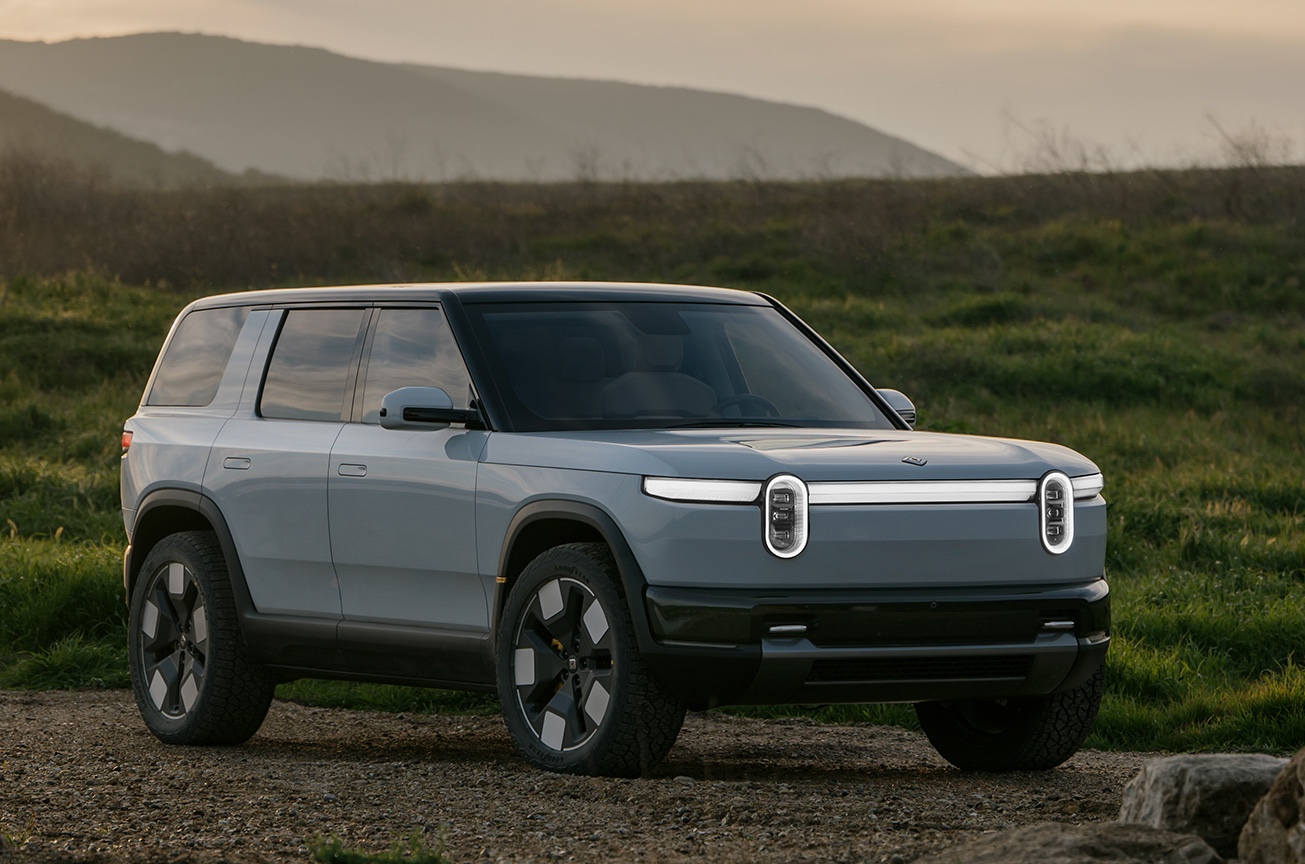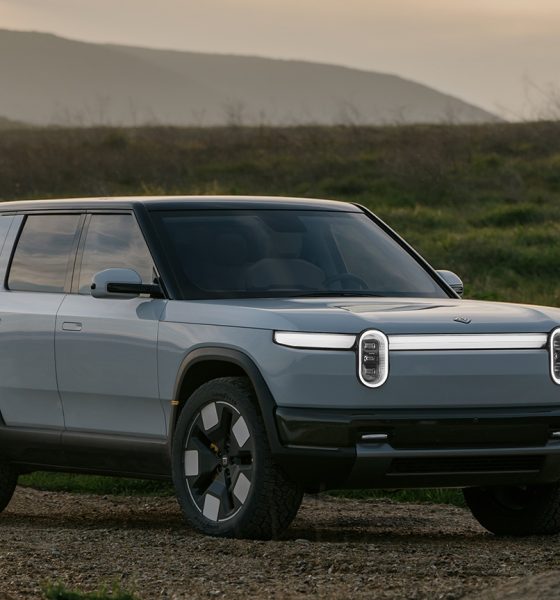Rivian has unveiled the R2, its next-generation platform. The all-electric crossover is expected to bring Rivian into the next chapter of its growth as an automaker. It is also expected to allow Rivian to scale its operations, making it a mainstream automaker.
Rivian CEO RJ Scaringe presented the R2 to an enthusiastic audience. Following is a quick overview of the Rivian R2.
Exterior
The Rivian R2 looks very similar to the Rivian R1S. Just like the flagship SUV, it features a large frunk that could fit some luggage and gear. At the rear, the R2 includes some features that provide an open-air experience, such as quarter windows that pop out and a rear glass window that drops down. The drop-down rear glass of the R2 also makes loading items to the all-electric crossover’s trunk much easier.
Introducing R2.
⚡️0-60 under 3 seconds.
⚡️Up to 300+ miles of range.
⚡️Room for five and all your gear.
Reserve yours now: https://t.co/1H408AWcA4
Deliveries expected to begin in the first half of 2026. The features, options and digital displays shown are subject to… pic.twitter.com/xC5ZjyaoCL— Rivian (@Rivian) March 7, 2024
Size-wise, Scaringe noted that the Rivian R2 is about 400 mm (15.7 inches) shorter than the R1S. A slide used in the presentation noted that the R2 has a length of 4715 mm (185.6 inches), a height of 1700 mm (66 inches), and a wheelbase of 2935 mm (115.5 inches). This should make the all-electric crossover easier to maneuver and drive. Its compact size should also help it fit in tight spaces and garages.
Interior
The Rivian executive noted that despite its more compact dimensions compared to the R1S, the R2 is designed to feel spacious inside. “It feels so inviting,” Scaringe said. Like the R1T and R1S that came before it, the R2 is also a vehicle that’s designed to be taken outdoors. It was thus no surprise to see that the R2’s second and first-row seats are capable of folding flat for an optimal car camping experience.
Take a 360-degree tour of R2. pic.twitter.com/euyJkScRYq— Rivian (@Rivian) March 7, 2024
Much to the amusement of the audience, Scaringe noted that the R2 features two gloveboxes and Rivian’s trademark in-door flashlight. Steering wheel controls are dominated by two large scroll wheels, which is not unlike what’s used in the previous generation Tesla Model 3. Scaringe also noted that the R2 features 11 cameras and a suite of five radar sensors, four in the corners and one long range radar in front. The cameras and radar should help the Rivian R2’s planned self-driving features.
Specs
Scaringe did not share much about the Rivian R2’s specs, though he did state that the vehicle would be equipped with a battery pack comprised of 4695 cylindrical cells, which are larger than the 21 mm cells used in the R1 platform. It should also be noted that the Rivian R2 will feature a structural bombardment pack, which means that the top of the battery will be the floor of the vehicle itself.
Every seat in R2 can lay flat for the ultimate car camping experience. pic.twitter.com/hDH3c17y5N— Rivian (@Rivian) March 7, 2024
The Rivian R2 will be offered in three versions: a Single Motor Rear Wheel Drive (RWD) variant, a Dual Motor All Wheel Drive (AWD) variant, and a Tri-Motor variant with two motors on the back and one motor at the front. Scaringe noted that all three R2 variants are expected to achieve over 300 miles of range. The Tri-Motor R2 is expected to achieve a 0-60 mph time of less than 3 seconds.
Price and Release Date
The Rivian R2 is expected to start at $45,000. While Scaringe did not discuss details on the vehicle’s pricing, this amount is likely true for the entry-level RWD version. Still, $45,000 is quite competitive, as the Tesla Model Y, a best-selling all-electric crossover, starts at $43,990 before options today.
Feel the breeze from all directions with the R2’s 360-degree open air experience, including powered rear glass. pic.twitter.com/GMKOEg5HpW— Rivian (@Rivian) March 7, 2024
Scaringe noted that the Rivian R2 is expected to start deliveries in the second half of 2026. The vehicle will initially be built at Rivian’s Normal, IL facility.
Watch Rivian’s R2 unveiling in the video below.
Don’t hesitate to contact us with news tips. Just send a message to simon@teslarati.com to give us a heads up.

News
Tesla is not sparing any expense in ensuring the Cybercab is safe
Images shared by the longtime watcher showed 16 Cybercab prototypes parked near Giga Texas’ dedicated crash test facility.

The Tesla Cybercab could very well be the safest taxi on the road when it is released and deployed for public use. This was, at least, hinted at by the intensive safety tests that Tesla seems to be putting the autonomous two-seater through at its Giga Texas crash test facility.
Intensive crash tests
As per recent images from longtime Giga Texas watcher and drone operator Joe Tegtmeyer, Tesla seems to be very busy crash testing Cybercab units. Images shared by the longtime watcher showed 16 Cybercab prototypes parked near Giga Texas’ dedicated crash test facility just before the holidays.
Tegtmeyer’s aerial photos showed the prototypes clustered outside the factory’s testing building. Some uncovered Cybercabs showed notable damage and one even had its airbags engaged. With Cybercab production expected to start in about 130 days, it appears that Tesla is very busy ensuring that its autonomous two-seater ends up becoming the safest taxi on public roads.
Prioritizing safety
With no human driver controls, the Cybercab demands exceptional active and passive safety systems to protect occupants in any scenario. Considering Tesla’s reputation, it is then understandable that the company seems to be sparing no expense in ensuring that the Cybercab is as safe as possible.
Tesla’s focus on safety was recently highlighted when the Cybertruck achieved a Top Safety Pick+ rating from the Insurance Institute for Highway Safety (IIHS). This was a notable victory for the Cybertruck as critics have long claimed that the vehicle will be one of, if not the, most unsafe truck on the road due to its appearance. The vehicle’s Top Safety Pick+ rating, if any, simply proved that Tesla never neglects to make its cars as safe as possible, and that definitely includes the Cybercab.
Elon Musk
Tesla’s Elon Musk gives timeframe for FSD’s release in UAE
Provided that Musk’s timeframe proves accurate, FSD would be able to start saturating the Middle East, starting with the UAE, next year.

Tesla CEO Elon Musk stated on Monday that Full Self-Driving (Supervised) could launch in the United Arab Emirates (UAE) as soon as January 2026.
Provided that Musk’s timeframe proves accurate, FSD would be able to start saturating the Middle East, starting with the UAE, next year.
Musk’s estimate
In a post on X, UAE-based political analyst Ahmed Sharif Al Amiri asked Musk when FSD would arrive in the country, quoting an earlier post where the CEO encouraged users to try out FSD for themselves. Musk responded directly to the analyst’s inquiry.
“Hopefully, next month,” Musk wrote. The exchange attracted a lot of attention, with numerous X users sharing their excitement at the idea of FSD being brought to a new country. FSD (Supervised), after all, would likely allow hands-off highway driving, urban navigation, and parking under driver oversight in traffic-heavy cities such as Dubai and Abu Dhabi.
Musk’s comments about FSD’s arrival in the UAE were posted following his visit to the Middle Eastern country. Over the weekend, images were shared online of Musk meeting with UAE Defense Minister, Deputy Prime Minister, and Dubai Crown Prince HH Sheikh Hamdan bin Mohammed. Musk also posted a supportive message about the country, posting “UAE rocks!” on X.
FSD recognition
FSD has been getting quite a lot of support from foreign media outlets. FSD (Supervised) earned high marks from Germany’s largest car magazine, Auto Bild, during a test in Berlin’s challenging urban environment. The demonstration highlighted the system’s ability to handle dense traffic, construction sites, pedestrian crossings, and narrow streets with smooth, confident decision-making.
Journalist Robin Hornig was particularly struck by FSD’s superior perception and tireless attention, stating: “Tesla FSD Supervised sees more than I do. It doesn’t get distracted and never gets tired. I like to think I’m a good driver, but I can’t match this system’s all-around vision. It’s at its best when both work together: my experience and the Tesla’s constant attention.” Only one intervention was needed when the system misread a route, showcasing its maturity while relying on vision-only sensors and over-the-air learning.
News
Tesla quietly flexes FSD’s reliability amid Waymo blackout in San Francisco
“Tesla Robotaxis were unaffected by the SF power outage,” Musk wrote in his post.

Tesla highlighted its Full Self-Driving (Supervised) system’s robustness this week by sharing dashcam footage of a vehicle in FSD navigating pitch-black San Francisco streets during the city’s widespread power outage.
While Waymo’s robotaxis stalled and caused traffic jams, Tesla’s vision-only approach kept operating seamlessly without remote intervention. Elon Musk amplified the clip, highlighting the contrast between the two systems.
Tesla FSD handles total darkness
The @Tesla_AI account posted a video from a Model Y operating on FSD during San Francisco’s blackout. As could be seen in the video, streetlights, traffic signals, and surrounding illumination were completely out, but the vehicle drove confidently and cautiously, just like a proficient human driver.
Musk reposted the clip, adding context to reports of Waymo vehicles struggling in the same conditions. “Tesla Robotaxis were unaffected by the SF power outage,” Musk wrote in his post.
Musk and the Tesla AI team’s posts highlight the idea that FSD operates a lot like any experienced human driver. Since the system does not rely on a variety of sensors and a complicated symphony of factors, vehicles could technically navigate challenging circumstances as they emerge. This definitely seemed to be the case in San Francisco.
Waymo’s blackout struggles
Waymo faced scrutiny after multiple self-driving Jaguar I-PACE taxis stopped functioning during the blackout, blocking lanes, causing traffic jams, and requiring manual retrieval. Videos shared during the power outage showed fleets of Waymo vehicles just stopping in the middle of the road, seemingly confused about what to do when the lights go out.
In a comment, Waymo stated that its vehicles treat nonfunctional signals as four-way stops, but “the sheer scale of the outage led to instances where vehicles remained stationary longer than usual to confirm the state of the affected intersections. This contributed to traffic friction during the height of the congestion.”
A company spokesperson also shared some thoughts about the incidents. “Yesterday’s power outage was a widespread event that caused gridlock across San Francisco, with non-functioning traffic signals and transit disruptions. While the failure of the utility infrastructure was significant, we are committed to ensuring our technology adjusts to traffic flow during such events,” the Waymo spokesperson stated, adding that it is “focused on rapidly integrating the lessons learned from this event, and are committed to earning and maintaining the trust of the communities we serve every day.”










